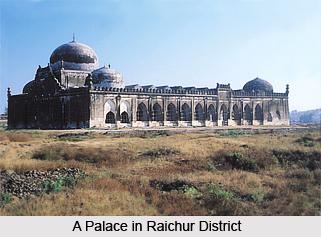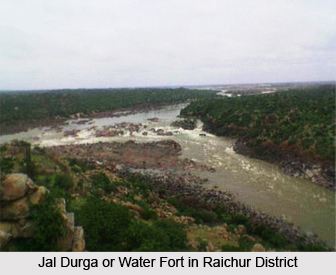 Tourism in Raichur district in Karnataka is a journey down the ages as the district is rich in historical associations and cultural traditions. It has a considerable number of places, which are of interest from the points of view of history, archaeology, religion, culture etc. A brief account of some of the more important places of interest in the district is discussed below.
Tourism in Raichur district in Karnataka is a journey down the ages as the district is rich in historical associations and cultural traditions. It has a considerable number of places, which are of interest from the points of view of history, archaeology, religion, culture etc. A brief account of some of the more important places of interest in the district is discussed below.
Places of historical interest are found in abundance in the Raichur district. Kallur, in Manvi taluk, is a large village, about 13 miles from Raichur. The village is surrounded on all sides by granite hills except the east and derives its name from the abundance of the boulders on these hills.
The village and the hills around are full of antiquities. The present village, which is a modern growth, is surrounded by an old wall, which appears to be a work of the 13th or 14th century A.D., though the five gates appear to be of Muslim period.
Two of them, which are not in much use, have no names. The other three are called after the towns to which they lead, namely, Manvi Darwaza, Kalmala Darwaza and Raichur Darwaza. The gates are more or less in a ruined condition. The superstructure of the Raichur Darwaza, which has been pulled down to construct the Chavadi in the village, contained a wooden inscription in the Kannada language. According to this inscription, which now forms part of the ceiling of the chavadi building, the gateway was constructed by Agha Khusru, a well known Adil Shahi dignitary. There are six temples in and around the village. Out of these, the Markandeshwara temple seems to be the oldest temple in the village and its hall has some pillars of black polished stone with beautiful carvings on them. A number of inscriptions have been found in this village, most of them belonging to the period of the Chalukyas of Kalyana.
Another interesting feature of Kallur is that there are many large and well-built wells. Five of these wells are very spacious, which have been built of solid masonry and have flights of steps leading to their base. It is not known when and by whom they were constructed. The largest well is 50 feet into 50 feet on the surface and about 120 feet deep and contains sweet water.
 Gabbur, in Deodurg taluk, was a centre of education in the old days. Found here are a number of temples and inscriptions. Gabbur was also known as Gopuragrama in the olden times. According to inscription dated 1109 A.D., belonging to the reign of Vikramaditya VI of the Chalukyas of Kalyana, now placed in the Hyderabad Archaeological Museum but originally belonging to a Jain Temple at Gabbur, the place (then called Gobbur or Hiriya Gobbur) was an agrahara town in the 12th century A.D. The same record states that it had also a Jain temple called Brahma-Jinalaya or Nagara-Jinalaya.
Gabbur, in Deodurg taluk, was a centre of education in the old days. Found here are a number of temples and inscriptions. Gabbur was also known as Gopuragrama in the olden times. According to inscription dated 1109 A.D., belonging to the reign of Vikramaditya VI of the Chalukyas of Kalyana, now placed in the Hyderabad Archaeological Museum but originally belonging to a Jain Temple at Gabbur, the place (then called Gobbur or Hiriya Gobbur) was an agrahara town in the 12th century A.D. The same record states that it had also a Jain temple called Brahma-Jinalaya or Nagara-Jinalaya.
Deodurg is the headquarters town of the taluk of the same name and is about 34 miles west of Raichur. It was formerly a stronghold of Bidar chieftains and has an old fort. Nearby, there is a hill, which contains talc.
Gurugunta, in Lingsugur taluk, was the chief town of a small principality (samsthana) of Naiks related to the chiefs of Kankgiri and Shorapur. In the old days, these chiefs owed allegiance to Vijayanagara kings or the Adil Shahi dynasty of Bijapur. The Gurugunta samsthana had survived under the Nizams and was merged in the district in 1949.
Jaladurga, in Lingsugur taluk, is an island fort situated picturesquely in the Krishna River, about eight miles from Lingsugur. It was an important fort of the Adil Shahs of Bijapur. The fort at Mudgal has a long history of dynastic rule behind it.
A number of places containing tools and items from pre historic times are also found at Raichur district. Maski, in Lingsugur taluk, is highly interesting from the points of view of prehistory and protohistory. It must have been a town of considerable size and importance in the remote past, as is evident from the traces of its iron and gold workings covering a large area, and from the references made to it in a number of inscriptions ranging from the 10th to the 16th century A.D. There is an abundance of artefacts found at the various sites located here. Among these sites, the so-called fields of Sultan Muhammad were found to be particularly rich in antiquities. These are believed to constitute the old town of Maski which was accessed from the riverside through a gorge amidst a ring of hills which surround the site. The hills have several spurs, the highest of which has a Shaivite temple which, from its architecture, appears to be of the 13th century A.D. On two other spurs near the gorge, are two other temples - one goldsmith`s and the other weaver`s. Weaving and gold-smelting are still the principal industries of the place. Neolithic implements like stone axes, hammers, flakes and cores and plain pottery were discovered at Lingsugur, and pre historic items were also found along the slopes of the hillocks at Kottekal. Artefacts, iron slag and pieces of ancient pottery have also been found at Kavital in the Manvi taluk.
The district of Raichur, as is evident from the above discussion, is rich in history and tradition. The various forts, ancient towns and historic sites are a must-see when visiting Raichur district.






